Experiment and Numerical Study on the Flexural Behavior of a 30 m Pre-Tensioned Concrete T-Beam with Polygonal Tendons
Abstract
1. Introduction
2. Experimental Setup and Beam Design
2.1. Model Overview
2.2. Fabrication of Test Beam
2.3. Loading Program
2.4. Measurement Program
3. Experimental Results
3.1. Test Phenomena
3.2. Experimental Bending Moment and Deflection of Mid-Span Relationship
- Elastic Stage: Prior to cracking, the secant stiffness was maintained at approximately 6.9 × 1016 N·mm2. At this stage, the beam exhibited linear elastic behavior with a proportional load-deflection response.
- Cracking stage: After the cracking point, the secant stiffness gradually declined. As the concrete developed tensile cracks while the steel reinforcement had not yielded, the slope of the load-deflection curve did not drop rapidly.
- Steel reinforcement yielding stage: When the steel reinforcement yielded, the secant stiffness reached 2.84 × 1016 N·mm2, and the slope of the load-deflection curve underwent a significant reduction.
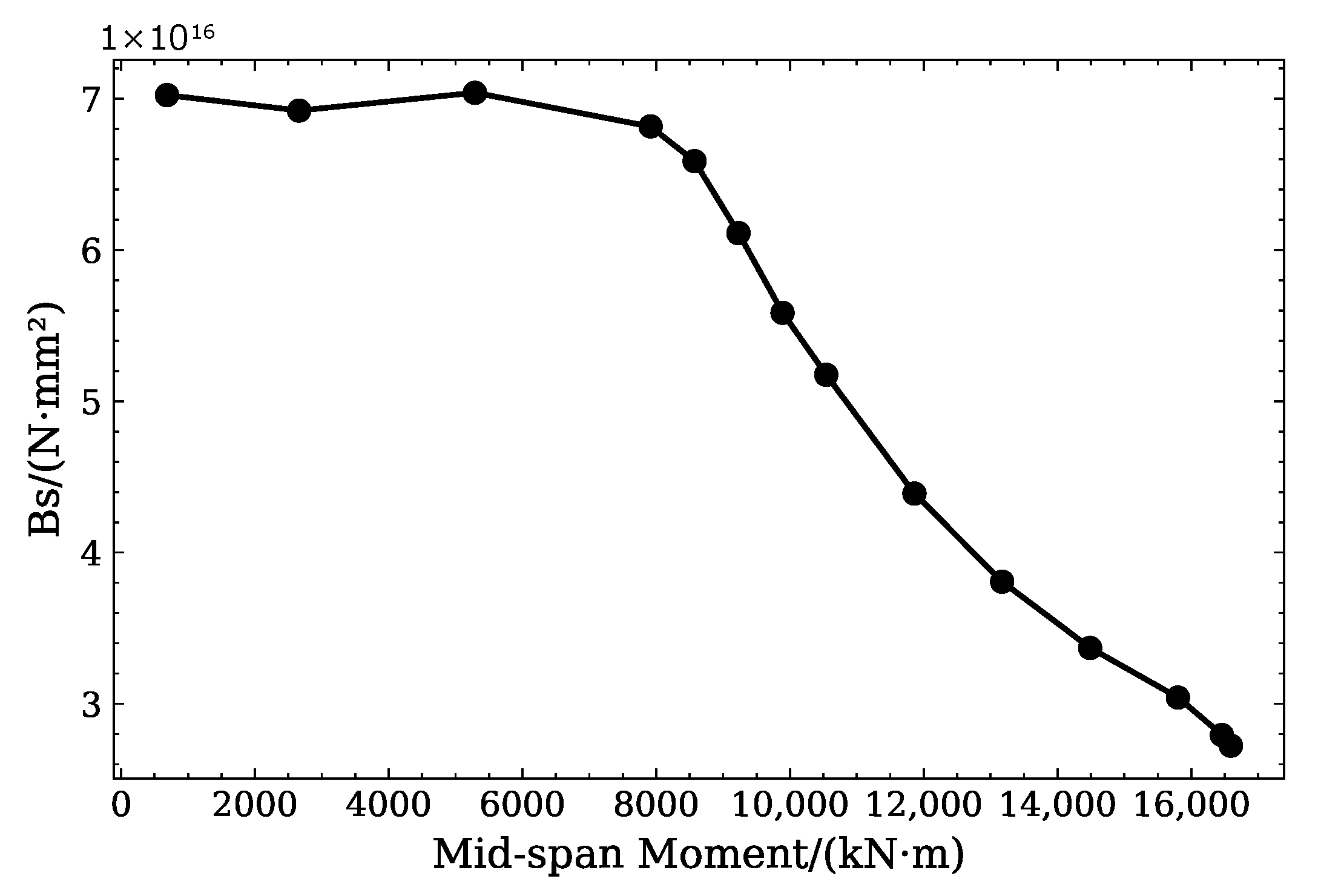
3.3. Strain Evolution and Cracking Pattern
3.3.1. Strain Evolution and Structural Response
3.3.2. Cracking Pattern
4. Numerical Simulation
4.1. Material and Element
4.2. Boundary Conditions and Interactions
4.3. Prestressing Force Simulation
4.4. Numerical Results and Validations
4.4.1. Load-Deflection Relationship
4.4.2. Strain and Damage
5. Conclusions
- The 30 m pre-tensioned, prestressed concrete T-beam in this research demonstrated outstanding flexural performance in terms of stiffness, crack resistance, and load-carrying capacity. During the serviceability phase, the measured mid-span deflection of the beam was notably smaller than the allowable value specified in codes. Visible cracks initiated when the load induced a mid-span calculated cross-sectional bending moment of 7916.85 kN·m, demonstrating excellent cracking resistance. The positive cross-section bending capacity at steel reinforcement yielding exceeded the theoretical design value, and the failure mode aligned with the flexural failure characteristics of the member.
- Before reaching the cracking moment, the test beam remained in an elastic deformation state. The secant stiffness stayed relatively constant, with a linear correlation between load and deflection. As the load approached the cracking moment, secant stiffness began to gradually decline, and the load-deflection curve exhibited nonlinear changes. When the load reached the steel reinforcement yielding point, secant stiffness was 2.84 × 1016 N·mm2, and the slope of the load-deflection curve dropped sharply.
- After loading the beam until steel reinforcement yielded and then unloading, most deflection could be recovered, leaving only a residual deflection of 10.68 mm. This benefited in maintaining structural performance after occasional overloading and subsequent structural utilization.
- Numerical simulation results indicated that the finite element model developed in this paper effectively simulated the flexural mechanical properties of the experimental T-beam. It also verified that the pre-tensioned, prestressed concrete T-beam with polygonal tendons designed in this research possessed favorable ductility.
Author Contributions
Funding
Data Availability Statement
Conflicts of Interest
References
- Akhnoukh, A.K. Accelerated Bridge Construction Projects Using High Performance Concrete. Case Stud. Constr. Mater. 2020, 12, e00313. [Google Scholar] [CrossRef]
- Zhou, X.; Zhang, X. Thoughts on the Development of Bridge Technology in China. Build. Struct. Mater. 2019, 5, 1120–1130. [Google Scholar] [CrossRef]
- Lantsoght, E.O.L.; Zarate Garnica, G.I.; Zhang, F.; Park, M.-K.; Yang, Y.; Sliedrecht, H. Shear Experiments of Pre-stressed Concrete Bridge Girders. ACI Struct. J. 2021, 118, 117–130. [Google Scholar] [CrossRef]
- Mustafa, S.; Lantsoght, E.O.L.; Yang, Y.; Sliedrecht, H. Numerical Analysis of Prestressed Concrete Bridge Girders Failing in Shear. ACI Struct. J. 2022, 119, 113–127. [Google Scholar] [CrossRef]
- Zhang, C. Research on the Application of Prestressing Technology with Pretensioned Draped Strands in Bridge Engineering. Shanghai Highw. 2020, 4, 41–44. [Google Scholar] [CrossRef]
- Liu, Z.; Lei, H.; Luo, J.; Zhang, C. Full-Scale Experimental Test on Flexural Behavior of a 30 m-Long Pretensioned Con-crete Double-Tee Girder. Bridge Constr. 2022, 52, 14–20. [Google Scholar]
- Wang, L.; Chen, J.; Yang, Y.; Zhu, Z.; Sun, B.; Shu, H. Full-scale Model Test on Flexural Performance of Double-broken Line Pre-tensioned High-strength Concrete I-beams. China J. Highw. Transp. 2023, 36, 169–179. [Google Scholar] [CrossRef]
- Wang, J.; Tang, S.; Zheng, H.; Zhou, C.; Zhu, M. Flexural Behavior of a 30-Meter Full-Scale Simply Supported Prestressed Concrete Box Girder. Appl. Sci. 2020, 10, 3076. [Google Scholar] [CrossRef]
- Garber, D.B.; Gallardo, J.M.; Deschenes, D.J.; Bayrak, O. Nontraditional Shear Failures in Bulb-T Prestressed Concrete Bridge Girders. J. Bridge Eng. 2016, 21, 04016030. [Google Scholar] [CrossRef]
- Hu, Z.; Lin, P.; Guo, H.; Xiang, Z. Evaluation of the Residual Bearing Capacity of Prestressed Concrete T-Girder Bridges Based on Bending Stiffness Reduction. J. Bridge Eng. 2025, 30, 04024107. [Google Scholar] [CrossRef]
- Yao, Z.; Wei, M.; Yan, H.; Yu, D.; Li, G.; Zhang, C.; Tao, J.; Pei, H. Experimental Study of Pre-Tensioned Polygonal Prestressed T-Beam Under Combined Loading Condition. Buildings 2025, 15, 1379. [Google Scholar] [CrossRef]
- Hussien, O.F.; Elafandy, T.H.K.; Abdelrahman, A.A.; Abdel Baky, S.A.; Nasr, E.A. Behavior of Bonded and Unbonded Prestressed Normal and High Strength Concrete Beams. HBRC J. 2012, 8, 239–251. [Google Scholar] [CrossRef]
- Singh, M. Experimental and Numerical Study of the Flexural Behaviour of Ultra-High Performance Fibre Reinforced Concrete Beams. Constr. Build. Mater. 2017, 138, 12–25. [Google Scholar] [CrossRef]
- Wang, H.-T.; Liu, X.-J.; Bai, J.; Yang, Y.; Xu, G.-W.; Chen, M.-S. Finite Element Modeling and Artificial Neural Network Analyses on the Flexural Capacity of Concrete T-Beams Reinforced with Prestressed Carbon Fiber Reinforced Polymer Strands and Non-Prestressed Steel Rebars. Buildings 2024, 14, 3592. [Google Scholar] [CrossRef]
- Yapar, O.; Basu, P.K.; Nordendale, N. Accurate Finite Element Modeling of Pretensioned Prestressed Concrete Beams. Eng. Struct. 2015, 101, 163–178. [Google Scholar] [CrossRef]
- Strauss, A.; Krug, B.; Slowik, O.; Novak, D. Combined Shear and Flexure Performance of Prestressing Concrete T-shaped Beams: Experiment and Deterministic Modeling. Struct. Concr. 2018, 19, 16–35. [Google Scholar] [CrossRef]
- Maghsoudi, M. Finite Element and Experimental Investigation on the Flexural Response of Pre-Tensioned T-Girders. Int. J. Civ. Eng. 2019, 17, 541–553. [Google Scholar] [CrossRef]
- ACI Committee. Building Code Requirements for Structural Concrete (ACI 318-19); American Concrete Institute: Farmington Hills, MI, USA, 2019. [Google Scholar]
- Long, Y.; Jiang, Z.; Zou, K.; Du, J.; Yang, J. Numerical Simulation Analysis of the Bending Performance of T-Beams Strengthened with Ultra-High-Performance Concrete Based on the CDP Model. Buildings 2024, 14, 1284. [Google Scholar] [CrossRef]
- Shen, J.; Zhang, X.; Wu, P.; Yue, K.; Chen, J. Experimental and Finite Element Analysis of Bending Performance of Web-Embedded Double Inverted T-Shaped Steel–Concrete Composite Beams. Buildings 2025, 15, 717. [Google Scholar] [CrossRef]
- Liu, J.; Cen, K.; Wang, Z.; Li, W.; Shi, L. Flexural Behavior of New Demountable Steel–Concrete Composite Beam with Novel Demountable Connectors. Buildings 2025, 15, 736. [Google Scholar] [CrossRef]
- GB/T 50152-2012; Standard for Test Methods of Concrete Structures. China Architecture & Building Press: Beijing, China, 2012.
- Hu, B.; Cai, Y.; Liu, H.; Wu, W.; He, B. The Stiffness Change in Pre-Stressed Concrete T-Beams during Their Life-Cycle Based on a Full-Scale Destructive Test. Appl. Sci. 2024, 14, 5200. [Google Scholar] [CrossRef]
- Nawy, E.G. Prestressed Concrete: A Fundamental Approach; Prentice Hall: Upper Saddle River, NJ, USA, 1999; ISBN 978-0-13-020593-3. [Google Scholar]
- GB/T 50010-2010; Specifications for Design of Concrete Structures. China Architecture & Building Press: Beijing, China, 2010.
- Lee, J.; Fellow, P.R. Plastic-Damage Model for Cyclic Loading of Concrete Structures. J. Eng. Mech. 1998, 124. [Google Scholar] [CrossRef]
- Li, Z.; Xu, Q.; Zeng, K.; Yu, X.; Gong, S.; Lu, Y. Flexural performance of pretensioned prestressed concrete solid square piles reinforced with steel strands and deformed steel bars. Struct. Concr. 2025, 1–23. [Google Scholar] [CrossRef]
- Li, X.-X.L. Parametric Study on Numerical Simulation of Missile Punching Test Using Concrete Damaged Plasticity (CDP) Model. Int. J. Impact Eng. 2020, 144, 103652. [Google Scholar] [CrossRef]
- Asgari, A.; Bagheri, M.; Hadizadeh, M. Advanced Seismic Analysis of Soil-Foundation-Structure Interaction for Shallow and Pile Foundations in Saturated and Dry Deposits: Insights from 3D Parallel Finite Element Modeling. Structures 2024, 69, 107503. [Google Scholar] [CrossRef]
- Bagheri, M.; Jamkhaneh, M.E.; Samali, B. Effect of Seismic Soil–Pile–Structure Interaction on Mid- and High-Rise Steel Buildings Resting on a Group of Pile Foundations. Int. J. Geomech. 2018, 18, 04018103. [Google Scholar] [CrossRef]

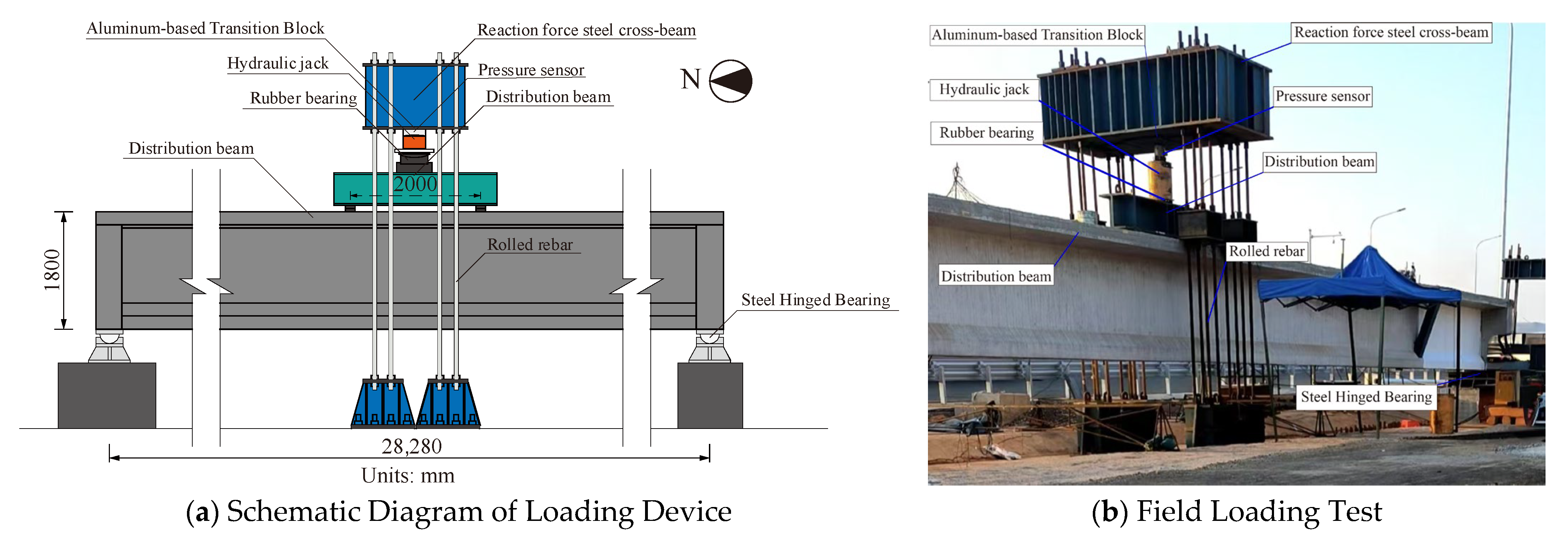
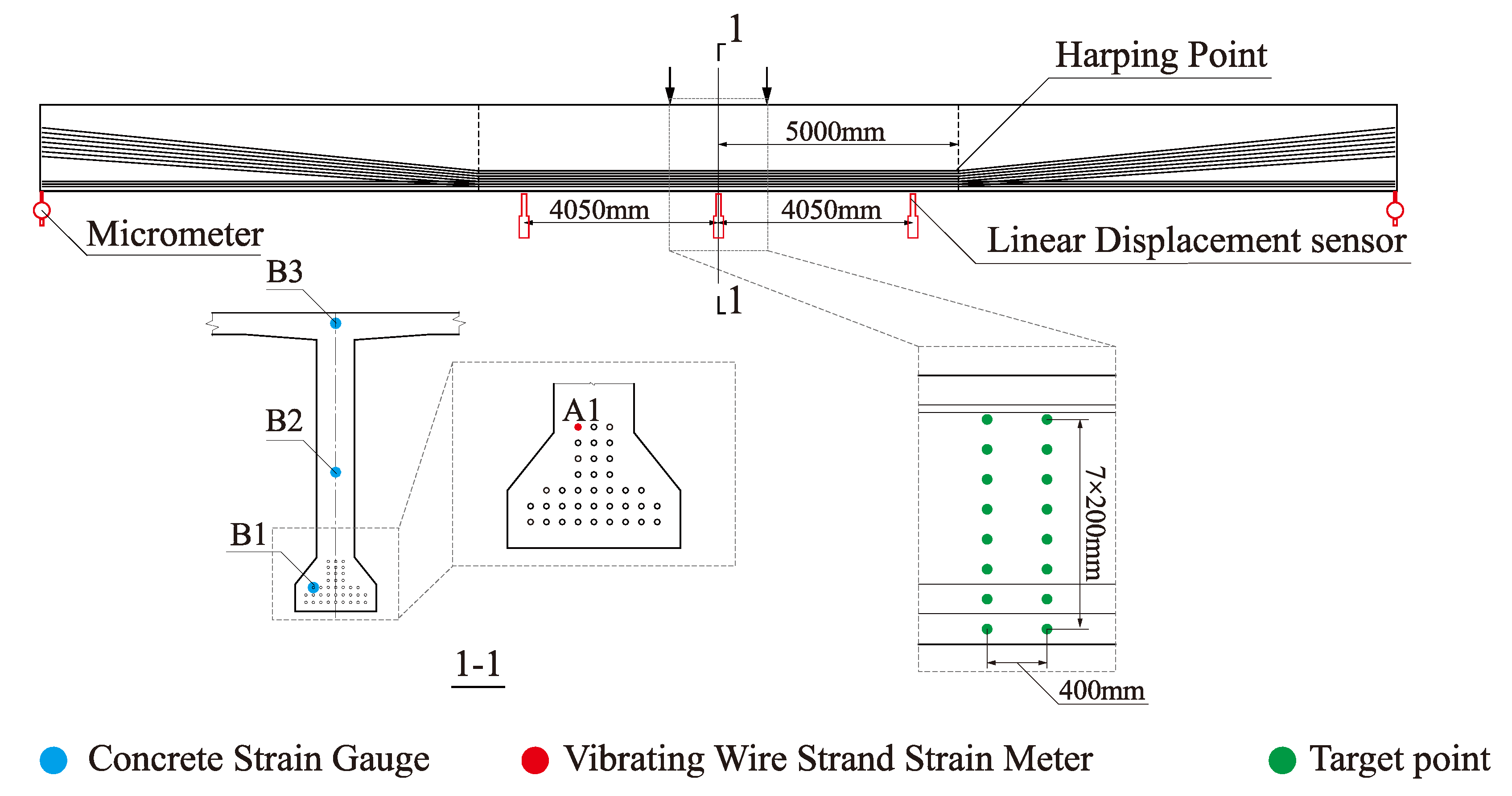
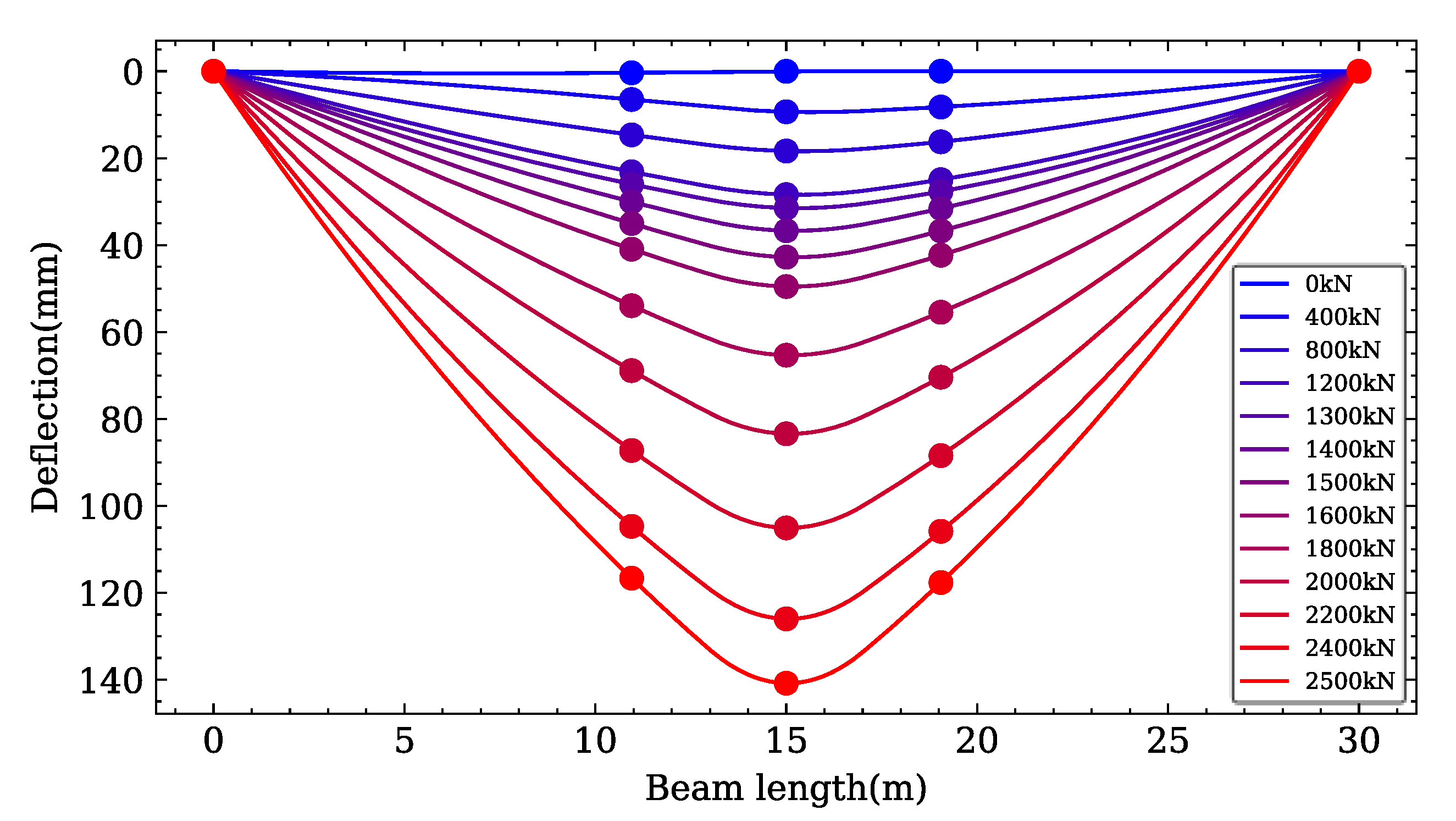
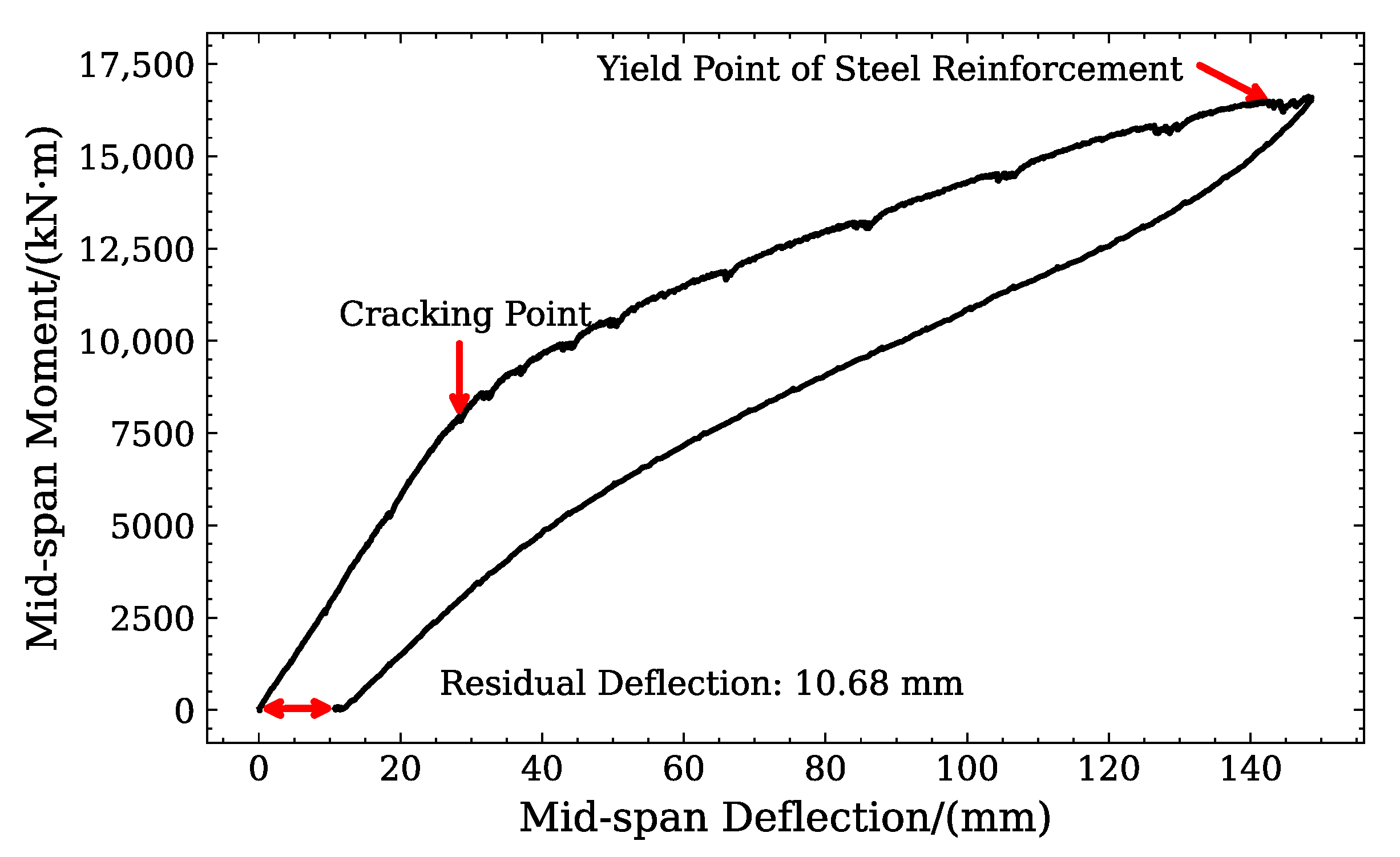
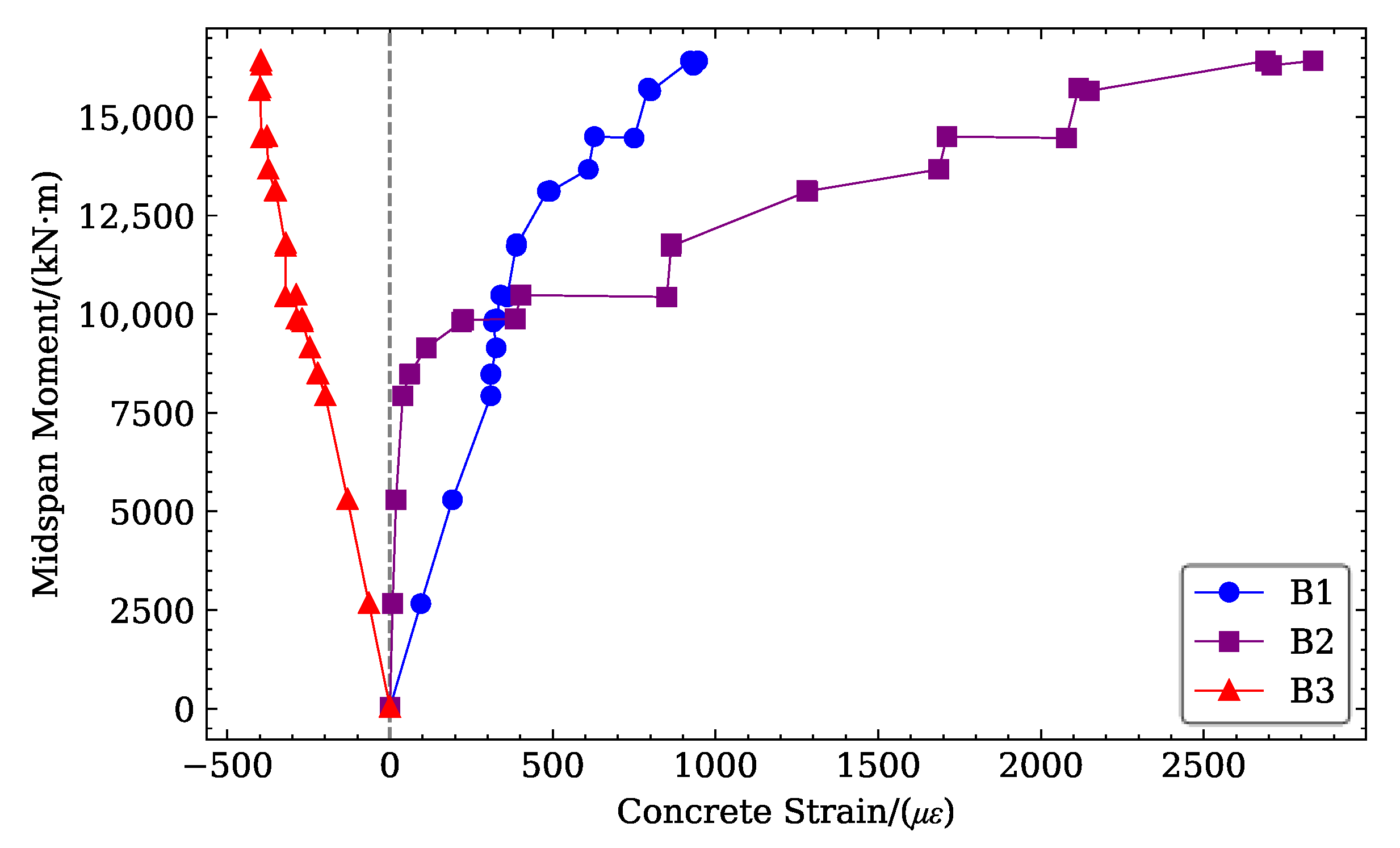
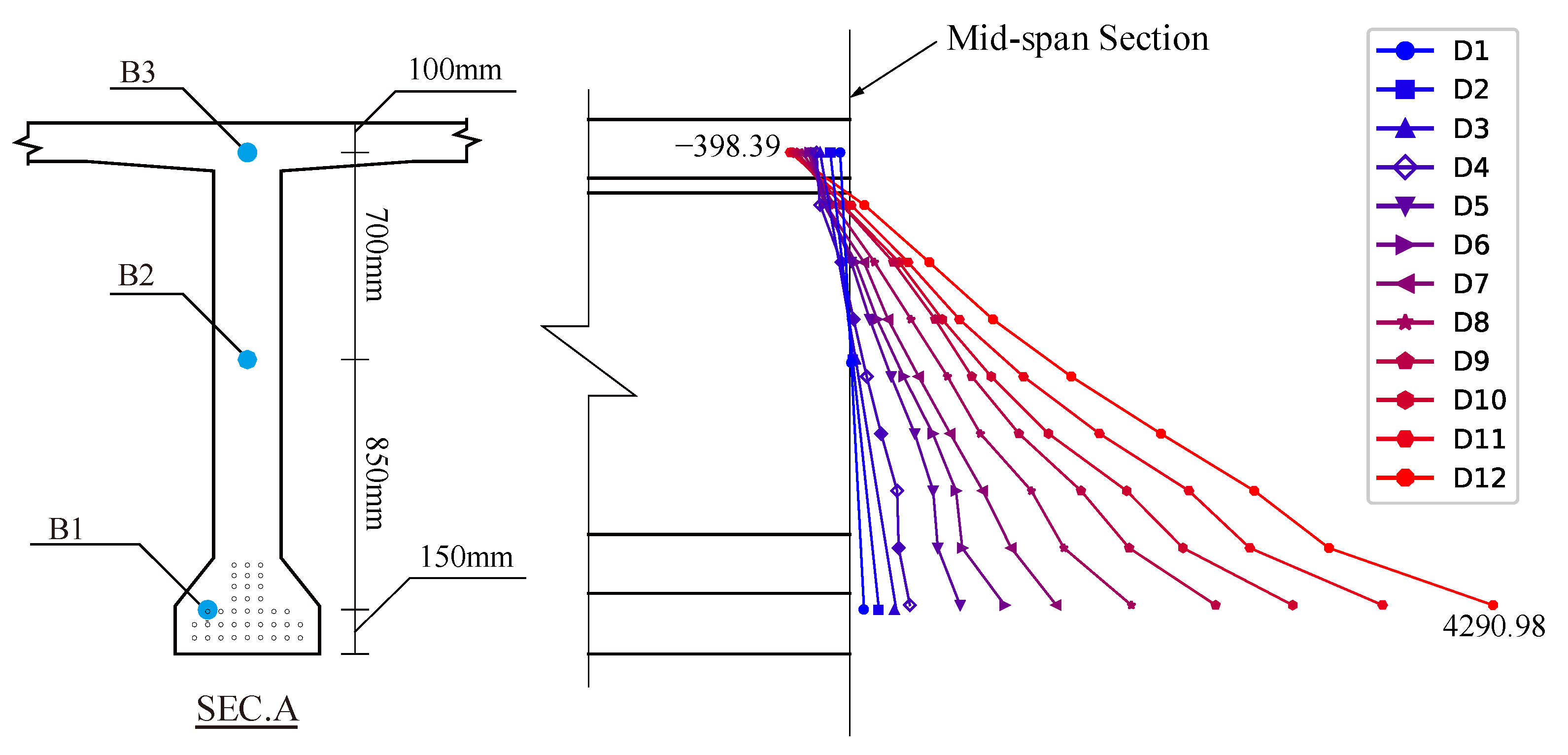
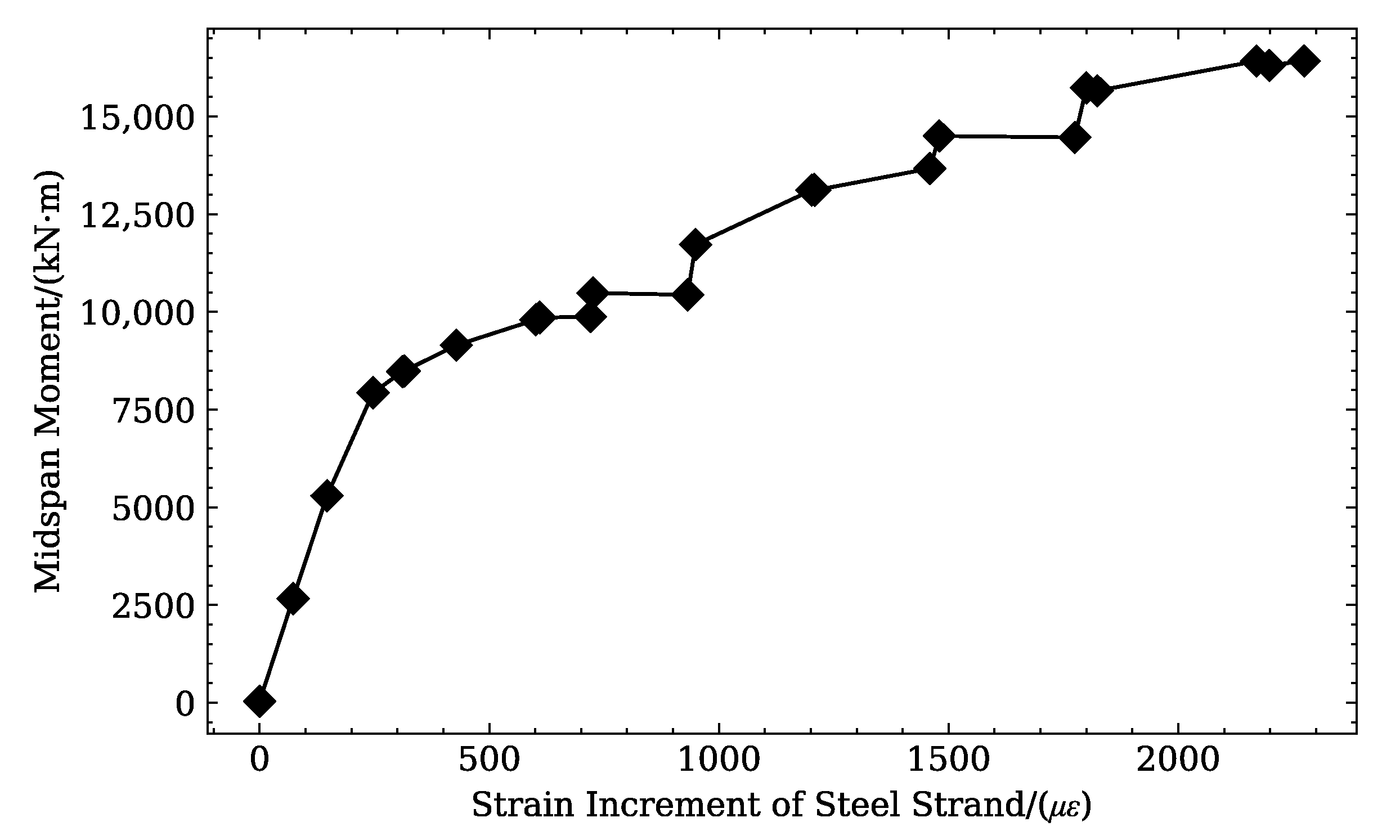


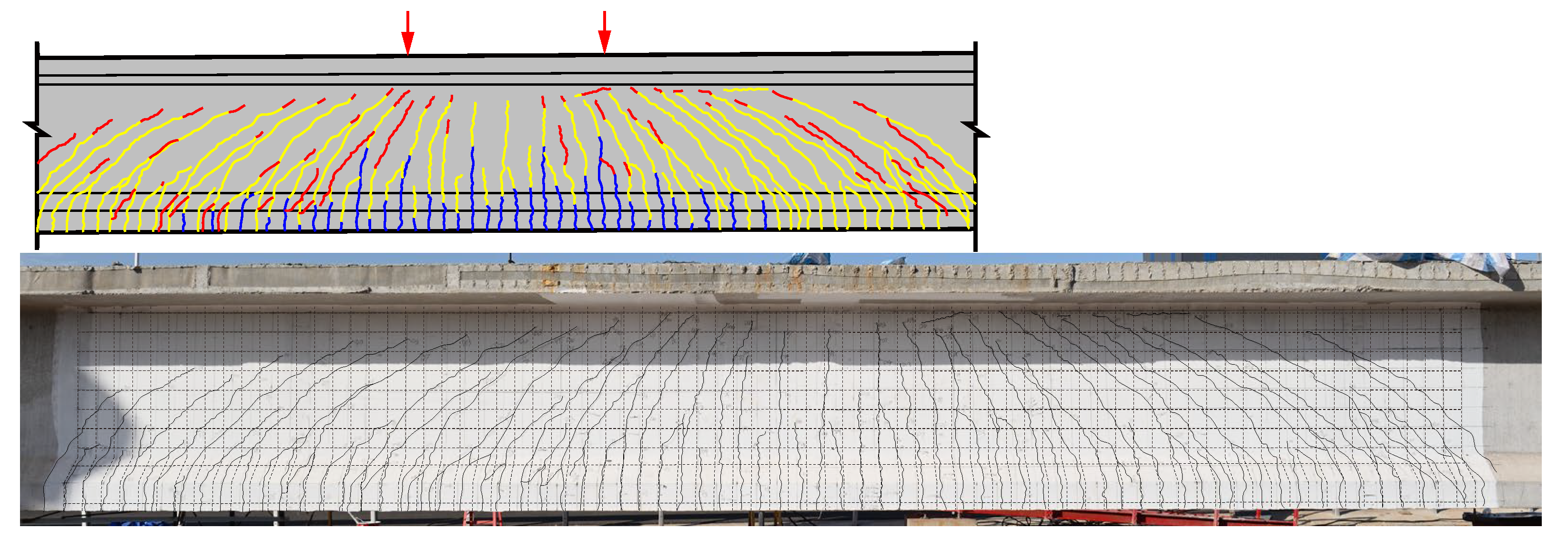
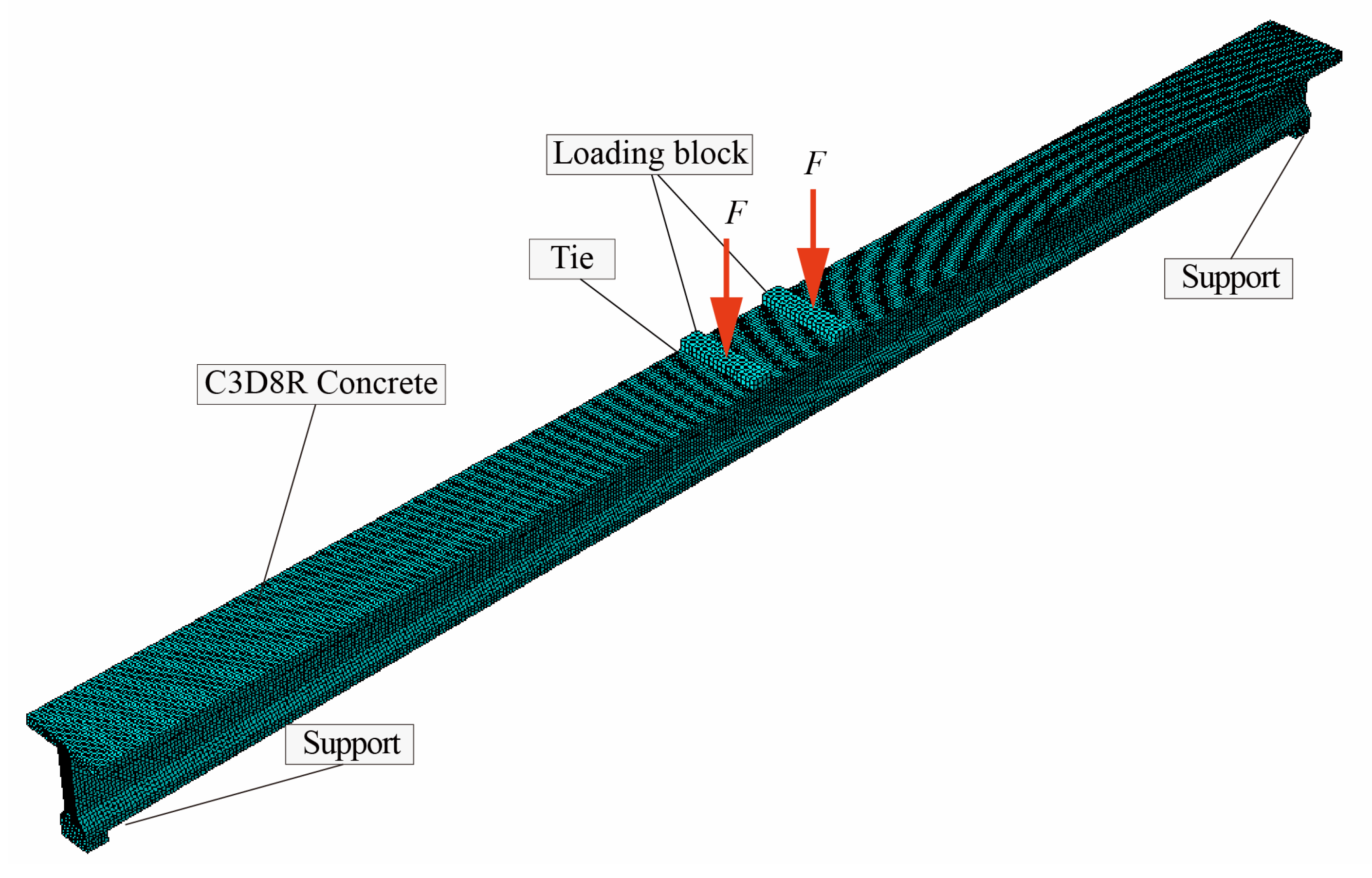

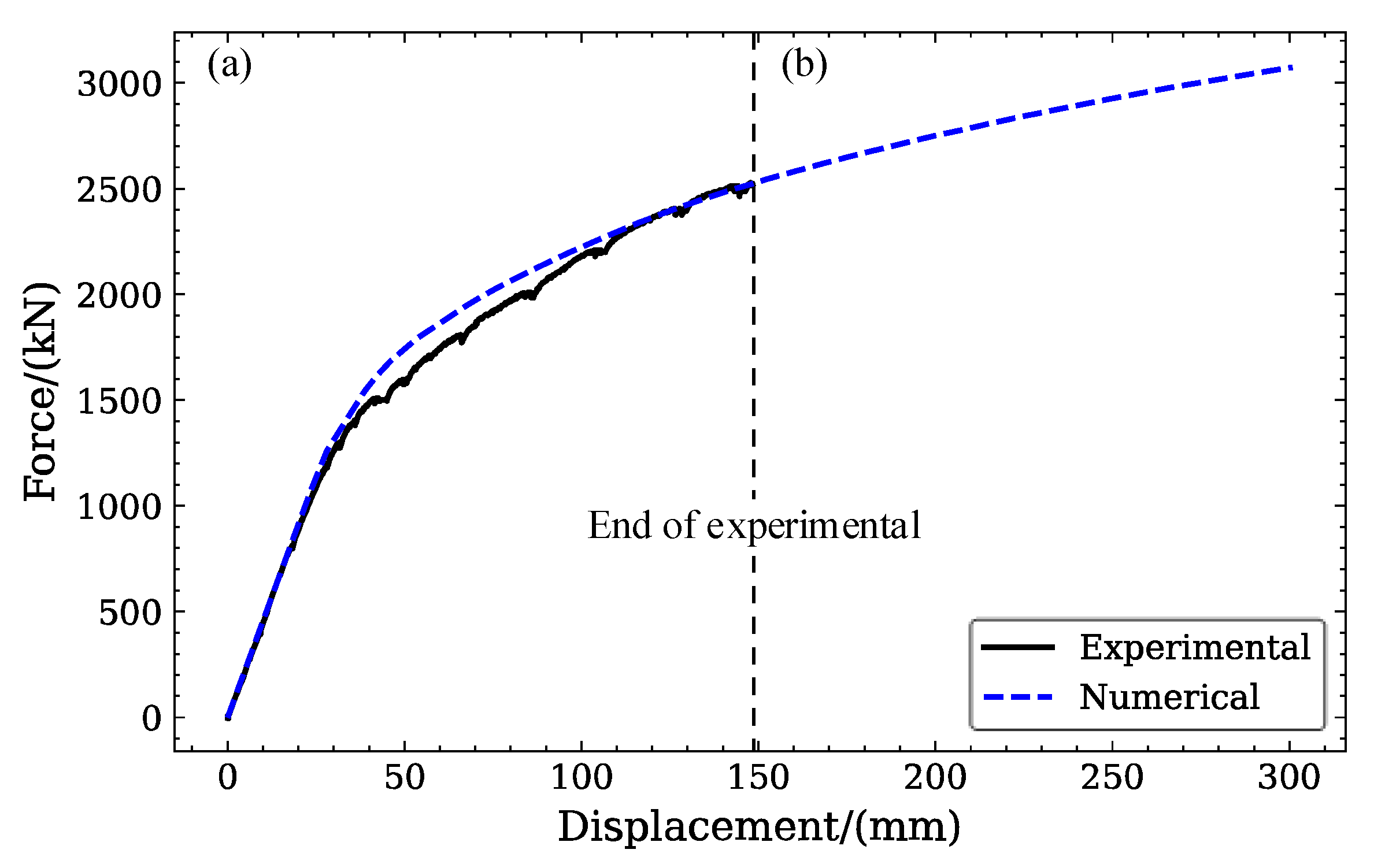

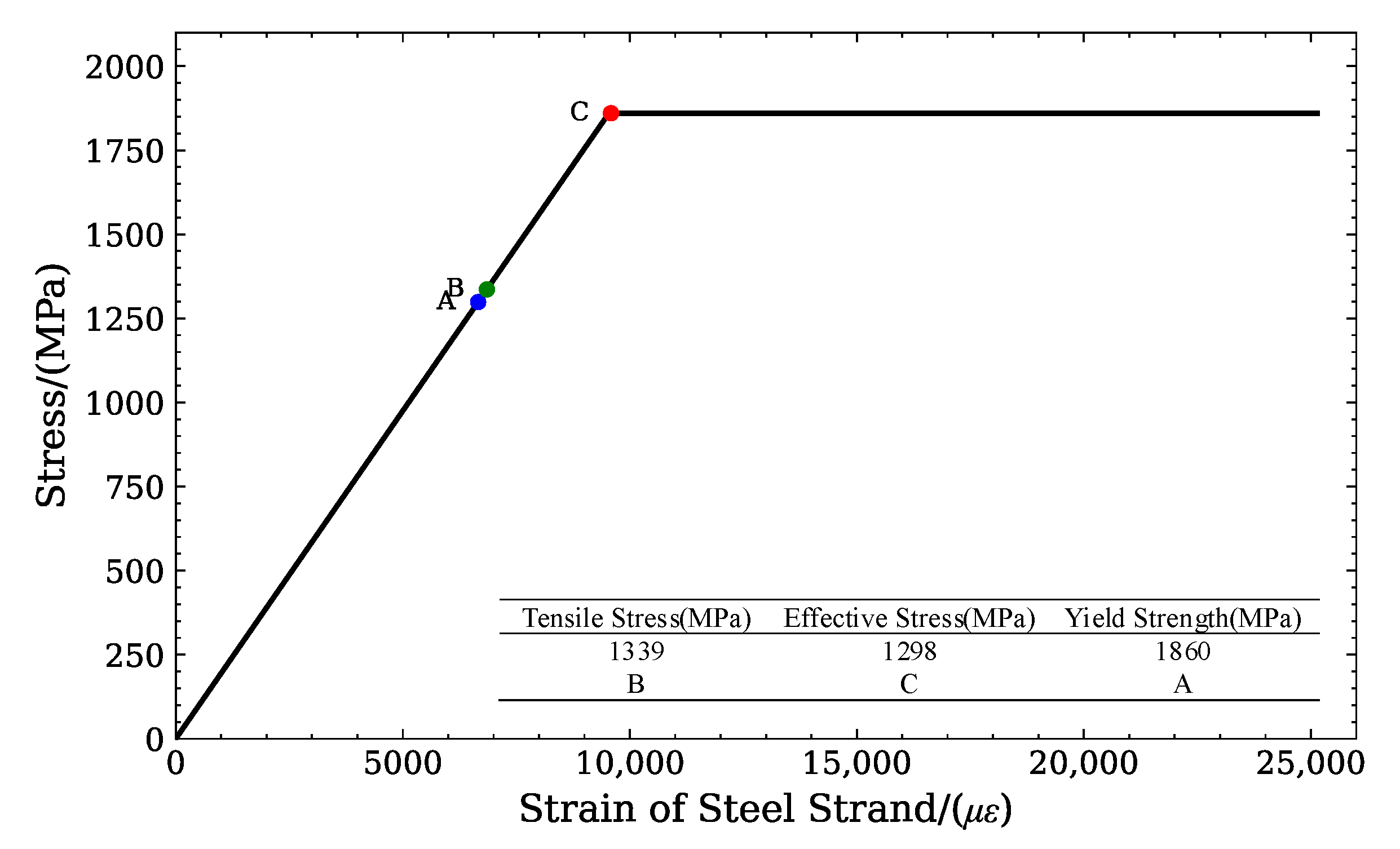
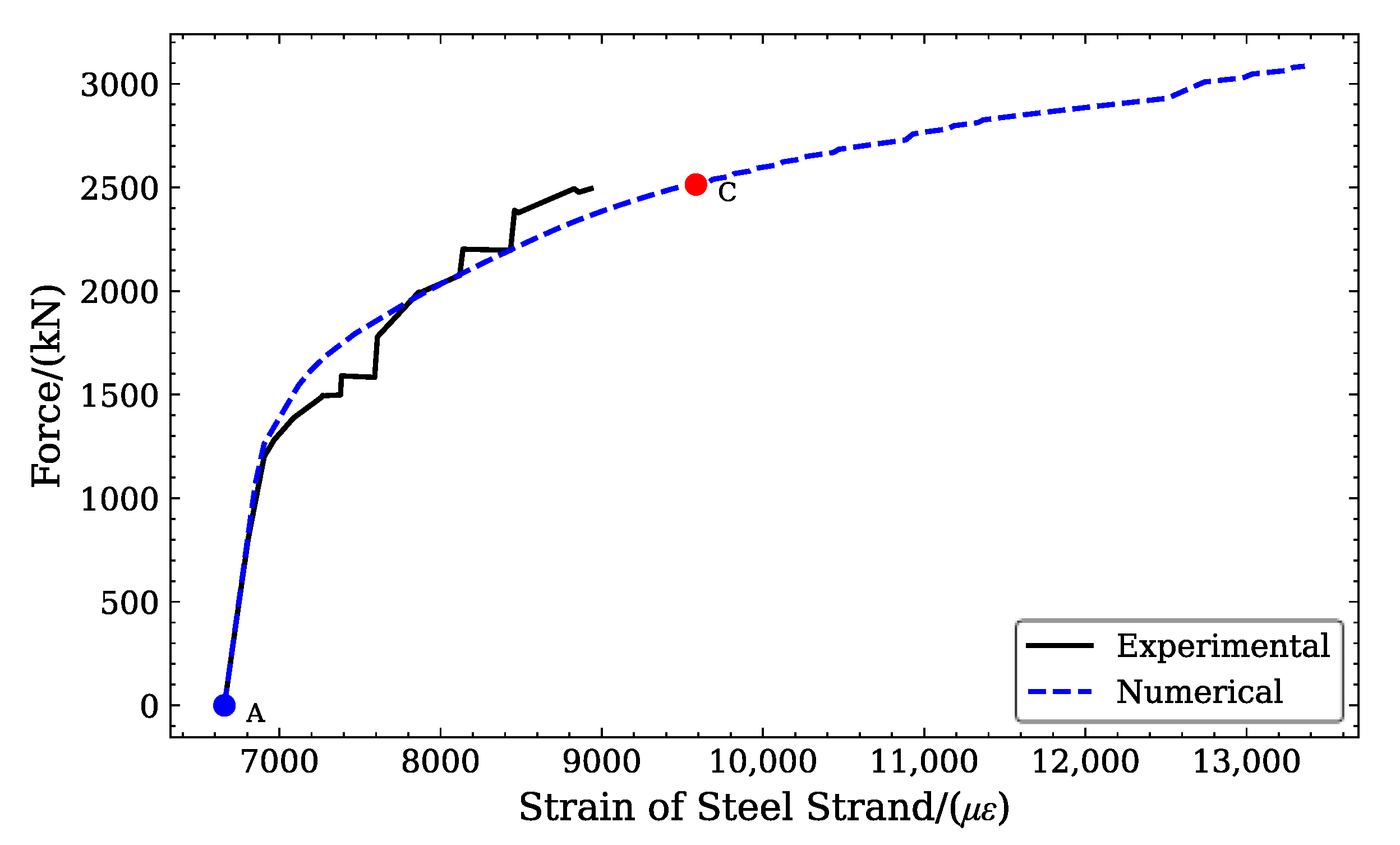

| Rebar Type | Yield Strength (MPa) | Ultimate Strength (MPa) | Modulus of Elasticity (GPa) |
|---|---|---|---|
| HRB300Փ10 | 332.0 | 461.2 | 200 |
| HRB400Փ12 | 418.0 | 595.4 | 200 |
| HRB400Փ14 | 446.0 | 580.4 | 200 |
| HRB400Փ28 | 432.0 | 614.1 | 200 |
| Steel Strand | - | 1860.0 | 195 |
| Loading Class | Total Load (kN) | Holding Time (min) |
|---|---|---|
| Preloading | —— | 5 |
| Unload | 0 | 5 |
| D1 | 400 | 5 |
| D2 | 800 | 5 |
| D3 | 1200 | 5 |
| D4 | 1300 | 5 |
| D5 | 1400 | 5 |
| D6 | 1500 | 5 |
| D7 | 1600 | 5 |
| D8 | 1800 | 5 |
| D9 | 2000 | 5 |
| D10 | 2200 | 5 |
| D11 | 2400 | 5 |
| D12 | 2500 | 5 |
| Unload | 0 | 5 |
Disclaimer/Publisher’s Note: The statements, opinions and data contained in all publications are solely those of the individual author(s) and contributor(s) and not of MDPI and/or the editor(s). MDPI and/or the editor(s) disclaim responsibility for any injury to people or property resulting from any ideas, methods, instructions or products referred to in the content. |
© 2025 by the authors. Licensee MDPI, Basel, Switzerland. This article is an open access article distributed under the terms and conditions of the Creative Commons Attribution (CC BY) license (https://creativecommons.org/licenses/by/4.0/).
Share and Cite
Yang, B.; Zhang, C.; Yan, H.; Yu, D.-H.; Xue, Y.; Li, G.; Wei, M.; Tao, J.; Pei, H. Experiment and Numerical Study on the Flexural Behavior of a 30 m Pre-Tensioned Concrete T-Beam with Polygonal Tendons. Buildings 2025, 15, 2595. https://doi.org/10.3390/buildings15152595
Yang B, Zhang C, Yan H, Yu D-H, Xue Y, Li G, Wei M, Tao J, Pei H. Experiment and Numerical Study on the Flexural Behavior of a 30 m Pre-Tensioned Concrete T-Beam with Polygonal Tendons. Buildings. 2025; 15(15):2595. https://doi.org/10.3390/buildings15152595
Chicago/Turabian StyleYang, Bo, Chunlei Zhang, Hai Yan, Ding-Hao Yu, Yaohui Xue, Gang Li, Mingguang Wei, Jinglin Tao, and Huiteng Pei. 2025. "Experiment and Numerical Study on the Flexural Behavior of a 30 m Pre-Tensioned Concrete T-Beam with Polygonal Tendons" Buildings 15, no. 15: 2595. https://doi.org/10.3390/buildings15152595
APA StyleYang, B., Zhang, C., Yan, H., Yu, D.-H., Xue, Y., Li, G., Wei, M., Tao, J., & Pei, H. (2025). Experiment and Numerical Study on the Flexural Behavior of a 30 m Pre-Tensioned Concrete T-Beam with Polygonal Tendons. Buildings, 15(15), 2595. https://doi.org/10.3390/buildings15152595






